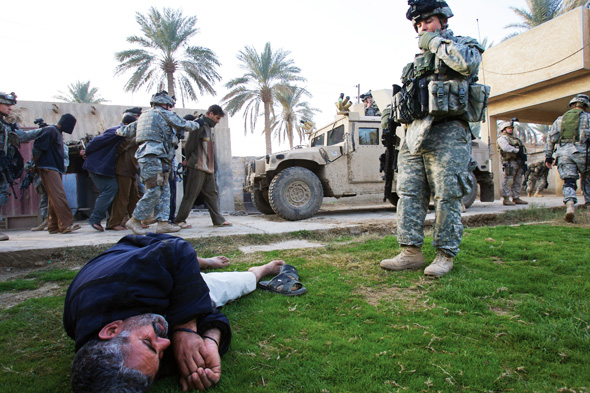
Ground war Following a raid in Ramadi in 2006, a US soldier watches over an Iraqi man who collapsed after being arrested. (Guy Calaf)
Michael Kamber’s new book, Photojournalists on War: The Untold Stories from Iraq, is a vital record of a conflict that will shape America, and Iraq, for decades to come. Kamber, who covered the war from beginning to end, founded the Bronx Documentary Center, a nonprofit gallery and educational space dedicated to documentary work around the world. Below is an excerpt from the book’s introduction.
This book grew out of late-night conversations with my fellow photojournalists: in plywood shacks on army bases in Mosul, on long drives through Sadr City, and on Baghdad rooftops as the occasional Katyusha crashed down across the Tigris.
Photographers are storytellers; most love to talk. As a group, I believe we saw more of the actual ground war than any group of civilian observers, save for the Iraqis, of course. When things got really bad, the TV crews often set up on the rooftops; some writers went out, but many worked the phones, or sent Iraqi stringers to the streets. The photographers had no options; if there was to be a picture in the newspaper the next day, the photojournalists were going out.
And so I learned something each time I sat down with a photojournalist. Stories unspooled about the invasion and the siege of Fallujah, about car bombings and the civil war, about run-ins with military brass. What I was hearing were the stories behind the news, stories I had not seen in the media, stories that sounded like history.
I left Iraq repeatedly and returned home to a public largely apathetic and poorly informed about the war. There was plenty of good reporting out there, and good photojournalism. Yet I lived with a nagging feeling that Americans were not seeing the war I knew.
By 2007 the embed rules had tightened considerably. The following became explicitly or effectively off limits: wounded and dead American soldiers; caskets of dead Americans; memorials for dead Americans (which we had previously been invited to); funerals at Arlington Cemetery (even when soldiers’ families requested media presence); Iraqi prisoners; car-bomb scenes. Franco Pagetti, the Italian photojournalist, and I were sent on civil affair patrols where soccer balls were distributed to children–this as battles raged nearby, battles we were kept away from. “It’s for your own safety,” we were told, as we loudly protested. And so censorship became the starting point for this book.
As I talked with my fellow photojournalists, I heard some of the same complaints, but their stories were also more complex. I was intrigued by how many photographers found sympathetic US commanders, were able to get graphic photos of the fighting and of US casualties, and told me that their editors refused to publish these images. And then the photographers’ stories went off in different directions. They rambled on about their families, their relationships, other conflicts, post-traumatic stress, the radically changing nature of the press. At first I tried to steer the conversations back to censorship. Then I let my friends talk, and this book became about something larger.
Michael Kamber is a contract photographer and writer for The New York Times who has chronicled many of the world’s major conflicts over the last decade. His interview with Bruce is part of his forthcoming book, the working title of which is Uncensored: A Photojournalists’ Oral History of the Iraq War. It is due out in 2012 from the University of Texas Press.
